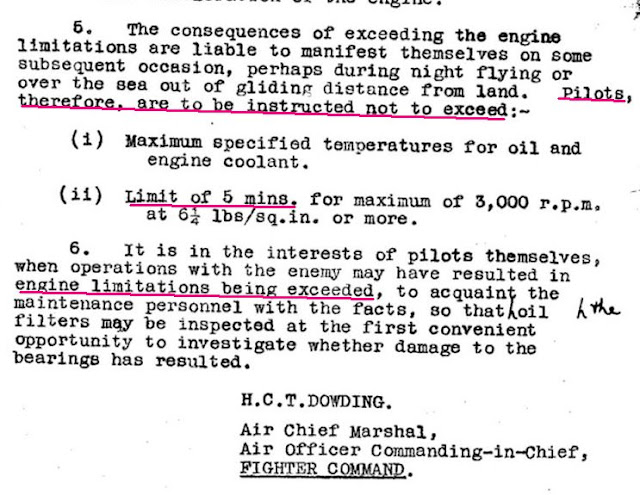Quote:
Originally Posted by ICDP

I don't entirely agree with his stance, nor do I agree with yours that an engineer could just shrug his shoulders and say don't worry about it. ALL engines regardless of what boost was used were inspected at the very least at the end of the days flying and preferably at the end of each flight timing permitted. Using +12lbs boost was by your own admission enough to warrant an inspection at the earliest possible convenience. The earliest possible convenience would be that very evening in the worst case scenario. When doing the routine maintenance at the end of each evening the engineer consults the logbooks of all aircraft flown that day. He sees that this particular aircraft has an entry that the pilot used +12lbs boost. He knows from his orders (Straight from Dowding) that it is SOP to do a more thorough check for wear and tear. Do you now dispute this?
|
First off, Dowding's memo states that oil filter checks were mandatory, "when convenient" for aircraft that
exceeded 5mins at 12lb/3000rpm:
Let's be very clear on this point.:

Quote:
Originally Posted by ICDP

Ah the bias starts to show. What you want is some "click here = win" button for the RAF? +12lbs boost gave a boost in performance, it was not a massive advantage that guaranteed victory. Even with +12lbs boost the difference in performance between a Spitfire, 109E and even a Hurricane were close enough that surprise, tactics and pilot skill was the determining factor in the outcome of any engagement.
|
No, want I want is historical accuracy. The Luftwaffe and RAF were locked in a constant technology battle that eventually saw the Luftwaffe field the Fw-190 when the RAF still had the Spit V and then the Me-262...but in 1940 the use of 100 octane fuel gave RAFFC greater power output at medium and low altitudes, when needed. This was the historical situation and I want the sim to reflect it.
I have read through every source on the Merlin engine that I have, and all the combat reports at:
http://www.wwiiaircraftperformance.org/
From what I can gather, Merlin engine failures, were primarily random events and the main culprit was manufacturing defects/design faults that eventually break the engine. The 50 hour 12lb/3000rpm test is an example of this, where the engine was cycled 100 times at 5min/20min at 12/4.5lb boost and eventually developed a coolant leak from a defect that plagued service engines that were not being run past 6.25lb.
The Merlin in Perspective states that fighters had a higher propensity for coolant leaks than bombers because fighters were cycling engine power from very low to very high much more frequently, but this was still not a common occurrence.
The next greatest problem was bearing failure from oil starvation, and again 12lb boost had little to do with this except for prolonged steep climbs, as per Dowding's memo, but probably the greatest cause was inverted flying and prolonged dives that caused excessive (~3600) RPM.
1939 Merlin TBO:
Fighters: 240 hrs
Bombers: 300 hrs
repair depots:
1942 onward: 35% of engines were there due to time expiry.
1942 onward: average engine under repair had 60% of nominal life, or 144 hrs for a fighter engine and 180 hrs for a bomber engine.
I would propose the following:
Any engine has a 65% probability of random major engine failure, during 240 hrs of operation, or about 160 sorties. Another way to express that would be a 6.5% probability of one aircraft out of 16 having major engine failure on a typical mission. I don't know how to model the use of 12lb/3000 rpm for more than 5mins, but a simple way would be be multiply the failure probability by, say 1.15, to simulate the increased RPM and stress on the engine.